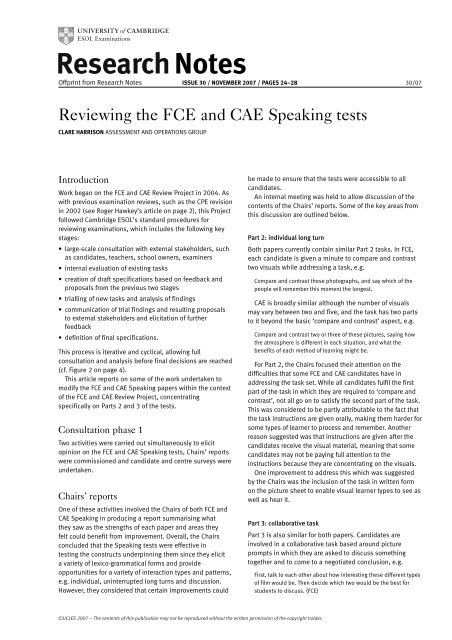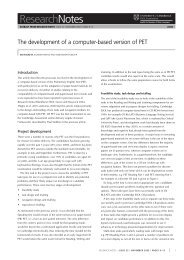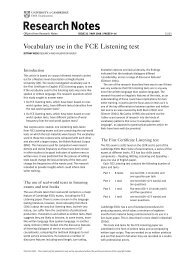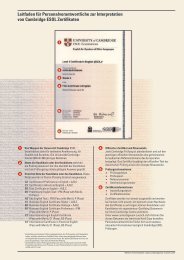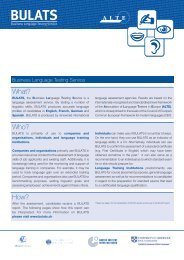Reviewing the FCE and CAE Speaking tests
Reviewing the FCE and CAE Speaking tests
Reviewing the FCE and CAE Speaking tests
Create successful ePaper yourself
Turn your PDF publications into a flip-book with our unique Google optimized e-Paper software.
Research NotesOffprint from Research Notes ISSUE 30 / NOVEMBER 2007 / PAGES 24–28 30/07<strong>Reviewing</strong> <strong>the</strong> <strong>FCE</strong> <strong>and</strong> <strong>CAE</strong> <strong>Speaking</strong> <strong>tests</strong>CLARE HARRISON ASSESSMENT AND OPERATIONS GROUPIntroductionWork began on <strong>the</strong> <strong>FCE</strong> <strong>and</strong> <strong>CAE</strong> Review Project in 2004. Aswith previous examination reviews, such as <strong>the</strong> CPE revisionin 2002 (see Roger Hawkey’s article on page 2), this Projectfollowed Cambridge ESOL’s st<strong>and</strong>ard procedures forreviewing examinations, which includes <strong>the</strong> following keystages:• large-scale consultation with external stakeholders, suchas c<strong>and</strong>idates, teachers, school owners, examiners• internal evaluation of existing tasks• creation of draft specifications based on feedback <strong>and</strong>proposals from <strong>the</strong> previous two stages• trialling of new tasks <strong>and</strong> analysis of findings• communication of trial findings <strong>and</strong> resulting proposalsto external stakeholders <strong>and</strong> elicitation of fur<strong>the</strong>rfeedback• definition of final specifications.This process is iterative <strong>and</strong> cyclical, allowing fullconsultation <strong>and</strong> analysis before final decisions are reached(cf. Figure 2 on page 4).This article reports on some of <strong>the</strong> work undertaken tomodify <strong>the</strong> <strong>FCE</strong> <strong>and</strong> <strong>CAE</strong> <strong>Speaking</strong> papers within <strong>the</strong> contextof <strong>the</strong> <strong>FCE</strong> <strong>and</strong> <strong>CAE</strong> Review Project, concentratingspecifically on Parts 2 <strong>and</strong> 3 of <strong>the</strong> <strong>tests</strong>.Consultation phase 1Two activities were carried out simultaneously to elicitopinion on <strong>the</strong> <strong>FCE</strong> <strong>and</strong> <strong>CAE</strong> <strong>Speaking</strong> <strong>tests</strong>, Chairs’ reportswere commissioned <strong>and</strong> c<strong>and</strong>idate <strong>and</strong> centre surveys wereundertaken.Chairs’ reportsOne of <strong>the</strong>se activities involved <strong>the</strong> Chairs of both <strong>FCE</strong> <strong>and</strong><strong>CAE</strong> <strong>Speaking</strong> in producing a report summarising what<strong>the</strong>y saw as <strong>the</strong> strengths of each paper <strong>and</strong> areas <strong>the</strong>yfelt could benefit from improvement. Overall, <strong>the</strong> Chairsconcluded that <strong>the</strong> <strong>Speaking</strong> <strong>tests</strong> were effective intesting <strong>the</strong> constructs underpinning <strong>the</strong>m since <strong>the</strong>y elicita variety of lexico-grammatical forms <strong>and</strong> provideopportunities for a variety of interaction types <strong>and</strong> patterns,e.g. individual, uninterrupted long turns <strong>and</strong> discussion.However, <strong>the</strong>y considered that certain improvements couldbe made to ensure that <strong>the</strong> <strong>tests</strong> were accessible to allc<strong>and</strong>idates.An internal meeting was held to allow discussion of <strong>the</strong>contents of <strong>the</strong> Chairs’ reports. Some of <strong>the</strong> key areas fromthis discussion are outlined below.Part 2: individual long turnBoth papers currently contain similar Part 2 tasks. In <strong>FCE</strong>,each c<strong>and</strong>idate is given a minute to compare <strong>and</strong> contrasttwo visuals while addressing a task, e.g.Compare <strong>and</strong> contrast <strong>the</strong>se photographs, <strong>and</strong> say which of <strong>the</strong>people will remember this moment <strong>the</strong> longest.<strong>CAE</strong> is broadly similar although <strong>the</strong> number of visualsmay vary between two <strong>and</strong> five, <strong>and</strong> <strong>the</strong> task has two partsto it beyond <strong>the</strong> basic ‘compare <strong>and</strong> contrast’ aspect, e.g.Compare <strong>and</strong> contrast two or three of <strong>the</strong>se pictures, saying how<strong>the</strong> atmosphere is different in each situation, <strong>and</strong> what <strong>the</strong>benefits of each method of learning might be.For Part 2, <strong>the</strong> Chairs focused <strong>the</strong>ir attention on <strong>the</strong>difficulties that some <strong>FCE</strong> <strong>and</strong> <strong>CAE</strong> c<strong>and</strong>idates have inaddressing <strong>the</strong> task set. While all c<strong>and</strong>idates fulfil <strong>the</strong> firstpart of <strong>the</strong> task in which <strong>the</strong>y are required to ‘compare <strong>and</strong>contrast’, not all go on to satisfy <strong>the</strong> second part of <strong>the</strong> task.This was considered to be partly attributable to <strong>the</strong> fact that<strong>the</strong> task instructions are given orally, making <strong>the</strong>m harder forsome types of learner to process <strong>and</strong> remember. Ano<strong>the</strong>rreason suggested was that instructions are given after <strong>the</strong>c<strong>and</strong>idates receive <strong>the</strong> visual material, meaning that somec<strong>and</strong>idates may not be paying full attention to <strong>the</strong>instructions because <strong>the</strong>y are concentrating on <strong>the</strong> visuals.One improvement to address this which was suggestedby <strong>the</strong> Chairs was <strong>the</strong> inclusion of <strong>the</strong> task in written formon <strong>the</strong> picture sheet to enable visual learner types to see aswell as hear it.Part 3: collaborative taskPart 3 is also similar for both papers. C<strong>and</strong>idates areinvolved in a collaborative task based around pictureprompts in which <strong>the</strong>y are asked to discuss somethingtoge<strong>the</strong>r <strong>and</strong> to come to a negotiated conclusion, e.g.First, talk to each o<strong>the</strong>r about how interesting <strong>the</strong>se different typesof film would be. Then decide which two would be <strong>the</strong> best forstudents to discuss. (<strong>FCE</strong>)©UCLES 2007 – The contents of this publication may not be reproduced without <strong>the</strong> written permission of <strong>the</strong> copyright holder.
2 | CAMBRIDGE ESOL : RESEARCH NOTES : ISSUE 30 / NOVEMBER 2007Talk to each o<strong>the</strong>r about what message <strong>the</strong>se picturescommunicate about <strong>the</strong> dictionary, <strong>and</strong> <strong>the</strong>n decide which picturewould be <strong>the</strong> best in appealing to people worldwide. (<strong>CAE</strong>)The Chairs felt that <strong>the</strong> task type works well <strong>and</strong> providesappropriate opportunity for assessment of <strong>the</strong> intendedtesting focus (exchanging ideas, agreeing <strong>and</strong> disagreeing,interactive communication etc.), but as with Part 2,discussion centred on <strong>the</strong> difficulties some c<strong>and</strong>idateshave in addressing each part of <strong>the</strong> task.Proposed improvements for Part 3 were: <strong>the</strong> inclusion of<strong>the</strong> task in written form on <strong>the</strong> picture sheet as for Part 2;<strong>and</strong> <strong>the</strong> creation of a ‘split task’ in which <strong>the</strong> Part 3 task isseparated into two parts, allowing c<strong>and</strong>idates two minutesto focus on <strong>the</strong> first part of <strong>the</strong> task <strong>and</strong> a fur<strong>the</strong>r minute tofocus on <strong>the</strong> second, e.g. for <strong>FCE</strong>:First, talk to each o<strong>the</strong>r about how interesting <strong>the</strong>se different filmswould be. (2 minutes)Now, decide which two would be <strong>the</strong> best for students to discuss.(1 minute)C<strong>and</strong>idate <strong>and</strong> centre surveysAt <strong>the</strong> same time as discussions were being held internally,opinions were also being canvassed externally by meansof a large-scale centre <strong>and</strong> c<strong>and</strong>idate survey. Feedbackreceived in response to this focused on similar issues tothose raised during <strong>the</strong> internal meeting. However,additional feedback was also received on <strong>the</strong> use ofvisuals as discussion prompts. Some respondents feltpicture-based tasks may not elicit a sample of languageappropriate to <strong>FCE</strong>/<strong>CAE</strong> level, <strong>and</strong> suggested that ra<strong>the</strong>rthan having visuals as prompts, <strong>FCE</strong> <strong>and</strong> <strong>CAE</strong> Part 2 taskscould be based on a question <strong>and</strong> word prompts, suchas are found in CPE, BEC, IELTS or Skills for Life<strong>Speaking</strong> 1 .Outcomes of <strong>the</strong> consultationThe two consultation activities indicated that it would bevaluable to explore a number of avenues for Parts 2 <strong>and</strong> 3of <strong>the</strong> <strong>Speaking</strong> <strong>tests</strong>. For example, it was suggested that,for Part 2, written task prompts could be added to <strong>the</strong>picture sheets. Trialling would <strong>the</strong>n be carried out to see ifc<strong>and</strong>idates find it easier to address <strong>the</strong> task set when <strong>the</strong>reis a written reminder of it for <strong>the</strong>m to refer to. If <strong>the</strong> abovewere found to be effective, fur<strong>the</strong>r trialling would beundertaken to determine <strong>the</strong> most appropriate form for <strong>the</strong>task prompt to take. Two forms were suggested: directquestions based on <strong>the</strong> task set or taken verbatim from <strong>the</strong>interlocutor’s task. Trialling would also be undertaken todetermine <strong>the</strong> most appropriate position on <strong>the</strong> picturesheet for <strong>the</strong> written-prompt to appear in.Although <strong>the</strong> use of written-prompts, such as appear inCPE, would result in a change of testing focus for <strong>FCE</strong> <strong>and</strong><strong>CAE</strong> Part 2 in that written-prompt tasks would not elicitlanguage for comparing or describing, it was decided thatItem Writers should be commissioned to produce suchtasks in order to explore <strong>the</strong> possibility of <strong>the</strong>ir use with <strong>FCE</strong><strong>and</strong> <strong>CAE</strong> c<strong>and</strong>idates. Research should <strong>the</strong>n be undertakencomparing <strong>the</strong> language elicited by <strong>the</strong> current picture tasks<strong>and</strong> <strong>the</strong> new written-prompt tasks.It was decided that for Part 3, as for Part 2, written taskprompts should be added to <strong>the</strong> picture sheet, <strong>and</strong> <strong>the</strong>effectiveness of this approach trialled as suggested above.Secondly, <strong>the</strong> Part 3 task should be trialled as a ‘split task’with <strong>the</strong> two parts of <strong>the</strong> task separated to allow c<strong>and</strong>idatesto focus on one part at a time.Task prompts on picture sheetsPicture sheets for Parts 2 <strong>and</strong> 3 were prepared to include awritten replication of <strong>the</strong> task instructions. Trialling wasundertaken with students preparing to take <strong>FCE</strong> <strong>and</strong> <strong>CAE</strong>,who carried out one current task, with instructions givensolely orally, <strong>and</strong> one updated task, with written taskprompts on <strong>the</strong> picture sheets alongside oral instructions.C<strong>and</strong>idates’ performance was recorded for <strong>the</strong> purpose ofanalysis, <strong>and</strong> <strong>the</strong>ir opinions on <strong>the</strong> experience of doing <strong>the</strong>two tasks were elicited.It was found that including written task prompts on <strong>the</strong>picture sheets increased c<strong>and</strong>idates’ confidence whenundertaking <strong>the</strong> tasks as <strong>the</strong>y felt that, if necessary, <strong>the</strong>ycould refer to <strong>the</strong> written-prompt if <strong>the</strong>y were not able toremember <strong>the</strong> task that had been addressed to <strong>the</strong>m.Although many c<strong>and</strong>idates did not refer to <strong>the</strong> prompts,knowing <strong>the</strong>y could do this was considered to bereassuring. Being able to refer back to <strong>the</strong> task wording wasshown to help c<strong>and</strong>idates focus fully on <strong>the</strong> task.Follow-up activity 1Once it had been established that written task prompts on<strong>the</strong> picture sheets helped c<strong>and</strong>idates to address <strong>the</strong> taskmore fully, fur<strong>the</strong>r trials were carried out to determine <strong>the</strong>most appropriate wording of <strong>the</strong>se. Two forms of taskprompt were trialled <strong>and</strong> compared. These were:A) Task prompts consisting of an exact replication of <strong>the</strong>wording used by <strong>the</strong> interlocutor, which is delivered in<strong>the</strong> form of an indirect question. E.g. <strong>the</strong> <strong>CAE</strong> interlocutorsays:I’d like you to compare <strong>and</strong> contrast two or three of <strong>the</strong>se pictures,saying how <strong>the</strong> atmosphere is different in each situation <strong>and</strong> what<strong>the</strong> benefits of each method of learning might be.<strong>and</strong> this is rendered as follows on <strong>the</strong> picture sheet:• how <strong>the</strong> atmosphere is different in each situation• what <strong>the</strong> benefits of each method of learning might beB) Task prompts consisting of <strong>the</strong> interlocutor’s wordsphrased as direct questions, e.g.:• How is <strong>the</strong> atmosphere different in each situation?• What might <strong>the</strong> benefits of each method of learning be?C<strong>and</strong>idates referring back to <strong>the</strong> task prompts found iteasier to do so when <strong>the</strong>se were phrased as directquestions.Follow-up activity 2Task prompts were trialled in three positions on <strong>the</strong> picturesheet: at <strong>the</strong> top; in <strong>the</strong> middle; at <strong>the</strong> bottom. It was found©UCLES 2007 – The contents of this publication may not be reproduced without <strong>the</strong> written permission of <strong>the</strong> copyright holder.
CAMBRIDGE ESOL : RESEARCH NOTES : ISSUE 30 / NOVEMBER 2007 | 3that centrally placed prompts were distracting forc<strong>and</strong>idates, <strong>and</strong> those located at <strong>the</strong> bottom of <strong>the</strong> pagewere easily overlooked. However, those placed at <strong>the</strong> top of<strong>the</strong> page proved to be positioned where c<strong>and</strong>idates couldsee <strong>and</strong> refer to <strong>the</strong>m without being obtrusive.Part 2 written-prompt tasks: a new tasktype for <strong>FCE</strong>/<strong>CAE</strong>?In response to feedback from some stakeholders whichhighlighted concerns that <strong>the</strong> Part 2 picture tasks do notelicit an appropriate level of language for <strong>FCE</strong> <strong>and</strong> <strong>CAE</strong>, itwas decided that an alternative task type, based on thatused for <strong>the</strong> long turn in CPE, should be trialled. Writersproduced tasks for <strong>FCE</strong> <strong>and</strong> <strong>CAE</strong> which were based on astatement of opinion, a question <strong>and</strong> three short prompts,for example (at <strong>FCE</strong> level):It’s difficult to keep fit <strong>and</strong> healthy nowadays. Do you agree?• eating healthy food• getting exercise• getting enough sleepThese were trialled with students preparing for <strong>FCE</strong> <strong>and</strong><strong>CAE</strong>, who carried out both a current Part 2 picture task <strong>and</strong>a written-prompt task to allow comparison. The c<strong>and</strong>idateswere recorded <strong>and</strong> opinions elicited as before. In addition,two post-trial research studies were undertaken,summarised below.Part 2 written-prompt vs. picture task: study 1Members of <strong>the</strong> Inter-Varietal Applied Corpus Studies(IVACS) research centre at <strong>the</strong> University of Limerick,Irel<strong>and</strong>, were invited to undertake in-depth analysis of <strong>the</strong>data collected from <strong>the</strong> trialling in order to comparec<strong>and</strong>idate output when doing written-prompt tasks in Part 2with output when doing <strong>the</strong> current picture-based task.Recordings of c<strong>and</strong>idates doing written-prompt <strong>and</strong>picture-based tasks were transcribed by researchers. Ineach case, <strong>the</strong> same c<strong>and</strong>idate carried out both a currentpicture-based task <strong>and</strong> an updated written-prompt task.Four transcripts of <strong>the</strong> written-prompt <strong>and</strong> four of <strong>the</strong>current picture-based tasks were analysed at each level.The same four students took part in each case, to allowcomparability. Researchers were asked to subjecttranscriptions of c<strong>and</strong>idate long turns to conversationanalysis in order to answer <strong>the</strong> following research question:In <strong>the</strong> case of <strong>the</strong> Part 2 long turn, is <strong>the</strong>re more evidence ofcoherence <strong>and</strong> cohesion in <strong>the</strong> c<strong>and</strong>idate output when carrying out<strong>the</strong> written-prompt task than when carrying out <strong>the</strong> picture-basedtask?The findings indicated that for both <strong>FCE</strong> <strong>and</strong> <strong>CAE</strong> Part 2<strong>the</strong> written-prompt tasks encouraged c<strong>and</strong>idates to producemore varied, coherent <strong>and</strong> complex language while <strong>the</strong>picture tasks seemed to produce less complex language<strong>and</strong> more hesitation. However, it should be noted that <strong>the</strong>picture-based tasks did not include <strong>the</strong> written questionprompts on <strong>the</strong> picture sheets.Part 2 written-prompt vs. picture task: study 2Independent of <strong>the</strong> study described above, a markingproject, based on <strong>the</strong> trial recordings, was also undertaken.This study was managed by Cambridge ESOL’s Research<strong>and</strong> Validation Group <strong>and</strong> aimed to investigate <strong>the</strong> scoresof eight c<strong>and</strong>idates responding to <strong>the</strong> <strong>FCE</strong> <strong>and</strong> eight to <strong>the</strong><strong>CAE</strong> Part 2 tasks with picture prompts <strong>and</strong> with writtenprompts.Each c<strong>and</strong>idate was rated by 12 experienced OralExaminers <strong>and</strong> scores recorded for Grammar <strong>and</strong>Vocabulary, Discourse Management <strong>and</strong> Pronunciationcriteria (Interactive Communication was not consideredrelevant to Part 2 as it involves no interaction between <strong>the</strong>c<strong>and</strong>idates). In addition, four of <strong>the</strong> examiners completedfunctional checklists to record <strong>the</strong> language functionselicited by <strong>the</strong> two task types. The research questions forthis study were:• Is <strong>the</strong>re any difference in aspects of performance on each test asreflected in <strong>the</strong> marks awarded?• Is <strong>the</strong>re any difference in aspects of performance on each test asreflected in <strong>the</strong> functions elicited?It was found that <strong>the</strong> <strong>CAE</strong> c<strong>and</strong>idates in <strong>the</strong> study achieveda higher score on <strong>the</strong> picture-prompt tasks than <strong>the</strong>y did on<strong>the</strong> written-prompt tasks while <strong>the</strong> <strong>FCE</strong> c<strong>and</strong>idates’ scoreswere fairly similar for both task types. The <strong>CAE</strong> c<strong>and</strong>idates’better scores may have been due to <strong>the</strong>ir familiarity with <strong>the</strong>picture task, having very likely also prepared for it at <strong>FCE</strong>level.In terms of functions, comparisons <strong>and</strong> descriptions weresignificantly more common with <strong>the</strong> picture-prompt tasks atboth <strong>FCE</strong> <strong>and</strong> <strong>CAE</strong> levels <strong>and</strong> resulted in more speculationat <strong>CAE</strong> level. The <strong>CAE</strong> written-prompt tasks, on <strong>the</strong> o<strong>the</strong>rh<strong>and</strong>, elicited significantly more elaboration of opinions<strong>and</strong> reasons for assertions.Part 3 ‘split’ task vs. current taskAt <strong>the</strong> start of <strong>the</strong> current Part 3 collaborative task,c<strong>and</strong>idates are set two different conversational goals. Theyare expected to structure <strong>the</strong> interaction in order to addressboth of <strong>the</strong>se. One of <strong>the</strong> proposals made by <strong>the</strong> Chairs inan attempt to help c<strong>and</strong>idates address fully both parts of<strong>the</strong> Part 3 task was to split <strong>the</strong> task <strong>and</strong> its instructions intotwo parts. In <strong>the</strong> ‘split’ task, <strong>the</strong> two conversational goalsare separated <strong>and</strong> sequenced by <strong>the</strong> interlocutor so thatc<strong>and</strong>idates receive only one task at <strong>the</strong> beginning of Part 3which is <strong>the</strong>n followed by <strong>the</strong> second task after <strong>the</strong>y havediscussed <strong>the</strong> first.The IVACS research team was again invited to undertakeresearch to compare c<strong>and</strong>idate output when <strong>the</strong>instructions for Part 3 were given in two stages (<strong>the</strong> socalled‘split’ task described above) with output on Part 3 in<strong>the</strong> current format. The research question which formed <strong>the</strong>basisofthisstudywas:In <strong>the</strong> Part 3 collaborative task, are <strong>the</strong>re differences in <strong>the</strong>language produced when c<strong>and</strong>idates are given instructions intwo stages as compared to when using <strong>the</strong> current instructionformat?The analysis of transcripts of c<strong>and</strong>idates doing both tasksshowed that although <strong>the</strong>re was little difference in terms of<strong>the</strong> linguistic complexity of c<strong>and</strong>idate output, <strong>the</strong>re were©UCLES 2007 – The contents of this publication may not be reproduced without <strong>the</strong> written permission of <strong>the</strong> copyright holder.
4 | CAMBRIDGE ESOL : RESEARCH NOTES : ISSUE 30 / NOVEMBER 2007differences in goal orientation <strong>and</strong> task completion.Researchers found that c<strong>and</strong>idates in <strong>the</strong> sample ei<strong>the</strong>r didnot address both parts of <strong>the</strong> current Part 3 task, or did soonly partially. It was found that c<strong>and</strong>idates worked toge<strong>the</strong>r,but <strong>the</strong>y often did not achieve task completion. In <strong>the</strong> ‘split’task, on <strong>the</strong> o<strong>the</strong>r h<strong>and</strong>, c<strong>and</strong>idates tended to achieve bothcollaboration <strong>and</strong> task completion <strong>and</strong> it was found thatseparating <strong>the</strong> rubric into two parts provided c<strong>and</strong>idateswith two manageable tasks to concentrate on one at a time,allowing <strong>the</strong>ir discussion to be more task-focused. It shouldbe noted, however, that task achievement per se is notdirectly assessed in <strong>the</strong> <strong>FCE</strong> <strong>and</strong> <strong>CAE</strong> <strong>Speaking</strong> <strong>tests</strong>, so<strong>the</strong>se findings would not affect <strong>the</strong> assessment of this task,<strong>and</strong> that, as in <strong>the</strong> Part 2 study, <strong>the</strong> tasks were of <strong>the</strong>current type which do not include written question promptson <strong>the</strong> picture sheets.Consultation phase 2Throughout <strong>the</strong> trialling phase, consultation with externalstakeholders continued. As trialling findings were known<strong>and</strong> fur<strong>the</strong>r proposals were made as a result, thisinformation was presented at consultation meetings withkey external stakeholders so that <strong>the</strong>ir opinion could besought. With regard to <strong>the</strong> <strong>Speaking</strong> <strong>tests</strong>, some Chairsagreed that <strong>the</strong> issue of some c<strong>and</strong>idates only partiallyaddressing <strong>the</strong> Part 2 <strong>and</strong> Part 3 tasks was <strong>the</strong> one that<strong>the</strong>y would most like to see addressed.The option of basing <strong>the</strong> long turn in Part 2 on writtenpromptselicited mixed opinions from stakeholders. Somefelt strongly that <strong>the</strong> current picture tasks work very well<strong>and</strong> should be retained, maintaining that c<strong>and</strong>idates like<strong>the</strong>m <strong>and</strong> that <strong>the</strong>y provide support for younger, or lesssophisticated c<strong>and</strong>idates, who may find it daunting to givea topical presentation such as is elicited by <strong>the</strong> writtenprompttask. In addition, some of those consulted pointedout that apart from YLE <strong>Speaking</strong> <strong>tests</strong>, <strong>the</strong> picture-basedtasks are unique to Main Suite within Cambridge ESOL <strong>and</strong>that for this reason it would be worth retaining <strong>the</strong>m.However, those in favour of <strong>the</strong> written-prompt tasks feltthat <strong>the</strong>se were more au<strong>the</strong>ntic than <strong>the</strong> picture tasks <strong>and</strong>would allow c<strong>and</strong>idates to produce more complex <strong>and</strong>coherent language.The proposal to separate <strong>the</strong> task instructions for Part 3also elicited a great deal of discussion. However, <strong>the</strong>re wasa minority of supporters for <strong>the</strong> ‘split’ task, who believedthat in testing as in teaching, it is unwise to set two tasks at<strong>the</strong> same time since it is hard to focus on both at once. Themajority of stakeholders were not keen on <strong>the</strong> ‘split’ task as<strong>the</strong>y felt that it would make Part 3 disjointed, with <strong>the</strong>examiner intervening in <strong>the</strong> middle of <strong>the</strong> interaction tosupply <strong>the</strong> second task. In addition, some of thoseconsulted felt that knowing <strong>the</strong> goal of <strong>the</strong> whole task,which is only apparent on hearing <strong>the</strong> second part of <strong>the</strong>instruction, is essential to give a reason for doing <strong>the</strong> firstpart of <strong>the</strong> task. They felt that c<strong>and</strong>idates could not carryout <strong>the</strong> discussion without knowing from <strong>the</strong> outset what<strong>the</strong> final goal is.Most stakeholders agreed that providing task prompts on<strong>the</strong> picture sheets in both Part 2 <strong>and</strong> Part 3 would be a wayto support c<strong>and</strong>idates in fully addressing <strong>the</strong> tasks.Final decisionsAt <strong>the</strong> end of <strong>the</strong> consultation <strong>and</strong> research process, all <strong>the</strong>feedback <strong>and</strong> findings were taken into consideration tomake final decisions about <strong>the</strong> content <strong>and</strong> format of <strong>the</strong><strong>Speaking</strong> <strong>tests</strong> from December 2008.Despite some of <strong>the</strong> findings from <strong>the</strong> small-scaleresearch conducted by <strong>the</strong> University of Limerick into <strong>the</strong>written-prompt Part 2 task, it was finally decided thatpictures should be retained at both <strong>FCE</strong> <strong>and</strong> <strong>CAE</strong> levels. Therationale for this decision takes into account <strong>the</strong> functions<strong>and</strong> topics of this task. The functions which form <strong>the</strong> basisof <strong>the</strong> testing focus of <strong>the</strong> long turn, i.e. comparing,describing, <strong>and</strong> in <strong>the</strong> case of <strong>CAE</strong>, speculating, areeffectively elicited by <strong>the</strong> current picture task. Thesefunctions are not so effectively elicited by <strong>the</strong> writtenprompts.Thus, replacing <strong>the</strong> picture tasks with writtenpromptsin Part 2 would have involved a considerablechange to <strong>the</strong> underlying construct of one part of <strong>the</strong><strong>Speaking</strong> test.The topics that could be used to form <strong>the</strong> basis of <strong>the</strong>written-prompts are similar to those that are already in usein <strong>the</strong> Part 3 collaborative task, e.g. lifestyle, <strong>the</strong> worldaround us, our working lives. Had <strong>the</strong> written-promptsbeen adopted for Part 2, c<strong>and</strong>idates could have found<strong>the</strong>mselves talking about similar topics in two parts of <strong>the</strong>test <strong>and</strong> also making use of similar lexis <strong>and</strong> languagefunctions to do this. Such linguistic <strong>and</strong> topic overlapwould have reduced opportunities to elicit a variedsample of language for assessment. It would <strong>the</strong>reforehave been necessary to re-think <strong>the</strong> focus <strong>and</strong> design of<strong>the</strong> collaborative task to avoid this potential overlap.In <strong>the</strong> final analysis, introducing written-prompts for Part 2appeared to necessitate a much greater change to <strong>the</strong><strong>Speaking</strong> <strong>tests</strong> than <strong>the</strong> review process had shown to benecessary or desirable. Similarly, for Part 3, whilst <strong>the</strong>re wasevidence from <strong>the</strong> research conducted by <strong>the</strong> University ofLimerick that indicated that <strong>the</strong> proposed ‘split’ task hadsome benefits over <strong>the</strong> current format in terms of goalorientation <strong>and</strong> encouraging c<strong>and</strong>idates to address bothparts of <strong>the</strong> task, <strong>the</strong>re were o<strong>the</strong>r more compelling reasonsto retain <strong>the</strong> current Part 3 format in <strong>the</strong> <strong>Speaking</strong> test. Theproposed change to a ‘split’ task would have resulted in agreater focus on task achievement than is desirable sincetask achievement is not assessed in <strong>the</strong> <strong>Speaking</strong> <strong>tests</strong> <strong>and</strong>,fur<strong>the</strong>rmore, some stakeholder <strong>and</strong> internal feedbackindicated strong resistance to <strong>the</strong> idea of separating <strong>the</strong>task into two parts.In <strong>the</strong> face of <strong>the</strong>se conflicting messages regardingPart 3, decision makers returned to <strong>the</strong> original issue raisedby <strong>the</strong> Chairs of <strong>the</strong> papers <strong>and</strong> also by centre <strong>and</strong>c<strong>and</strong>idate survey respondents, which focused on enablingc<strong>and</strong>idates to fully address <strong>the</strong> tasks set, <strong>and</strong> determinedon a course of action that would both address <strong>the</strong> issue <strong>and</strong>take account of stakeholders’ views.It was <strong>the</strong>refore decided that as <strong>the</strong> picture tasks wereessentially popular <strong>and</strong> working well, <strong>the</strong>y should beretained in both Parts 2 <strong>and</strong> 3. However, to address <strong>the</strong>issue of task focus in both parts, picture sheets shouldinclude task prompts, which c<strong>and</strong>idates could refer to,allowing <strong>the</strong>m to deal fully with <strong>the</strong> task set. Trialling had©UCLES 2007 – The contents of this publication may not be reproduced without <strong>the</strong> written permission of <strong>the</strong> copyright holder.
CAMBRIDGE ESOL : RESEARCH NOTES : ISSUE 30 / NOVEMBER 2007 | 5shown this approach to be successful <strong>and</strong> feedback fromstakeholders regarding this proposal had been positive.ConclusionAlthough this review has resulted in only slight changes to<strong>the</strong> <strong>Speaking</strong> <strong>tests</strong>, <strong>the</strong> research carried out <strong>and</strong> opinionsga<strong>the</strong>red on <strong>the</strong> subject have provided Cambridge ESOLwith a wealth of valuable information. Clearly, monitoring<strong>and</strong> reviewing our <strong>tests</strong> is an iterative process <strong>and</strong> <strong>the</strong>insights afforded by <strong>the</strong> current review will act as aspringboard for review projects of <strong>the</strong> future.This is an extract from Research Notes, published quarterly by University of Cambridge ESOL Examinations.Previous issues are available online from www.CambridgeESOL.org©UCLES 2007 – The contents of this publication may not be reproduced without <strong>the</strong> written permission of <strong>the</strong> copyright holder.


